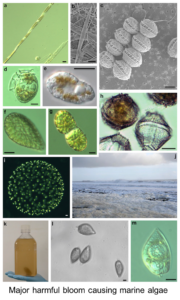 We have partnered with several regional desalination projects to examine the potential for harmful and nuisance algal blooms to negatively impact desalination processes operating or planning to operate along the coast of southern California. This work has included projects conducted with the West Basin Municipal Water District, Long Beach Seawater Desalination Center, and the Carlsbad Desalination Plant. Our early studies involved research with the West Basin Municipal Water District and Trussell Technologies, Inc., to examine the interaction between Harmful Algal Blooms (HABs) and the processes of desalination of ocean water. This project addressed the fates and possible impacts of phytoplankton-derived toxins and excessive plankton biomass on the quality of intake water for desalination facilities and the permeate produced by the reverse osmosis process (see publications by Caron et al. 2010, and Seubert et al. 2012). The West Basin project entailed coastal ocean monitoring at two pilot desalination facility sites in Santa Monica Bay, CA (El Segundo and the City of Redondo Beach), as well as laboratory work to investigate toxin loading onto reverse osmosis membranes. Field monitoring consisted of two moored ocean buoys that measured a variety of parameters to inform scientists and plant operators of the chemical and biological condition of the intake water. These parameters included temperature, salinity, chlorophyll, suspended particulate matter and dissolved oxygen at both a near surface depth (~0.5 m) and a near bottom depth (~15 m). Phosphorous was also measured at the near surface depth. Additionally, weekly water samples were collected from the intake water and from the reverse osmosis permeate. These samples were analyzed for the presence of phytoplankton-derived neurotoxins. The goal of this component of the project was to examine the potential for these toxins to pass through the membranes and into the permeate.
We have partnered with several regional desalination projects to examine the potential for harmful and nuisance algal blooms to negatively impact desalination processes operating or planning to operate along the coast of southern California. This work has included projects conducted with the West Basin Municipal Water District, Long Beach Seawater Desalination Center, and the Carlsbad Desalination Plant. Our early studies involved research with the West Basin Municipal Water District and Trussell Technologies, Inc., to examine the interaction between Harmful Algal Blooms (HABs) and the processes of desalination of ocean water. This project addressed the fates and possible impacts of phytoplankton-derived toxins and excessive plankton biomass on the quality of intake water for desalination facilities and the permeate produced by the reverse osmosis process (see publications by Caron et al. 2010, and Seubert et al. 2012). The West Basin project entailed coastal ocean monitoring at two pilot desalination facility sites in Santa Monica Bay, CA (El Segundo and the City of Redondo Beach), as well as laboratory work to investigate toxin loading onto reverse osmosis membranes. Field monitoring consisted of two moored ocean buoys that measured a variety of parameters to inform scientists and plant operators of the chemical and biological condition of the intake water. These parameters included temperature, salinity, chlorophyll, suspended particulate matter and dissolved oxygen at both a near surface depth (~0.5 m) and a near bottom depth (~15 m). Phosphorous was also measured at the near surface depth. Additionally, weekly water samples were collected from the intake water and from the reverse osmosis permeate. These samples were analyzed for the presence of phytoplankton-derived neurotoxins. The goal of this component of the project was to examine the potential for these toxins to pass through the membranes and into the permeate.
There were four main objectives in this project:
- Compile a summary and literature review of the phytoplankton taxa that pose a potential threat to the operation of a coastal desalination plant, and the possible toxins/effects that they may produce.
- Establish the response of reverse osmosis (RO) filtration to specific phytoplankton-derived toxins as a means of establishing baseline information of the potential problem(s) these toxins pose to the RO process.
- Conduct water sample analyses to monitor phytoplankton taxonomic characterization and specific phytoplankton-derived toxins in intake water from two desalination pilot plants.
- Equip two desalination pilot plants with real-time sensors to enable “sentinel” measurements of pertinent chemical/physical/biological parameters that might indicate an impending or emerging phytoplankton bloom or other event.